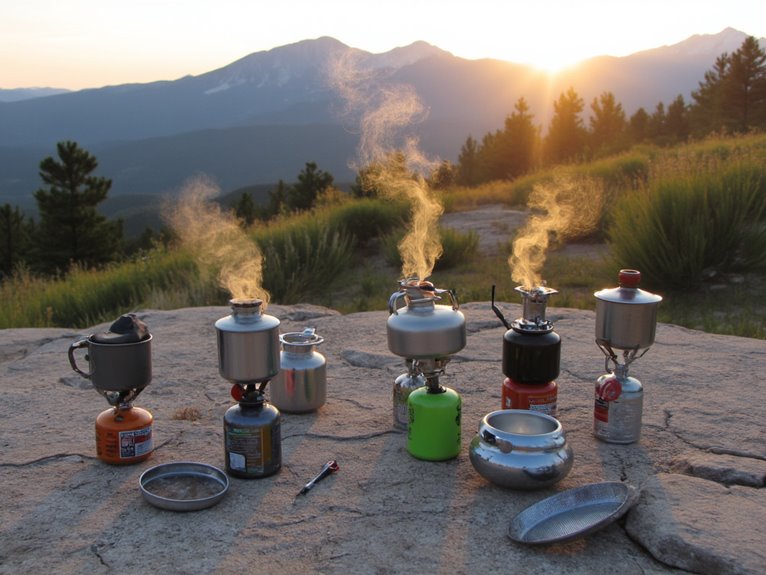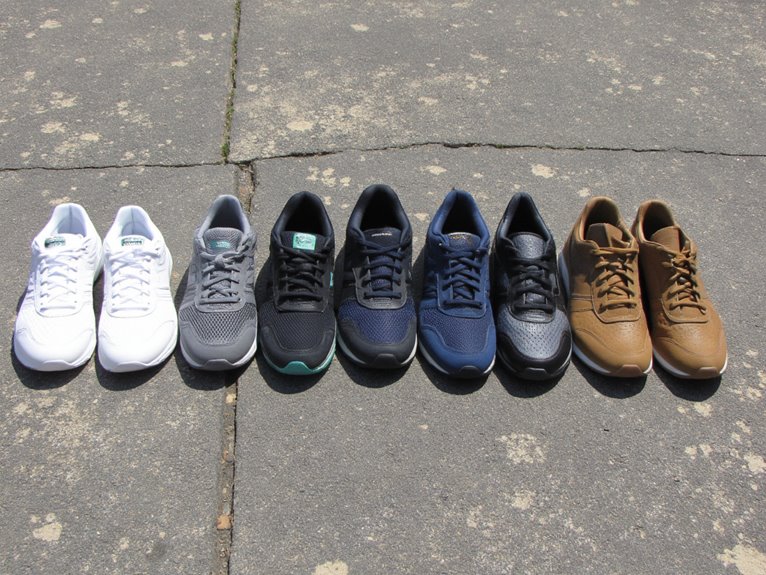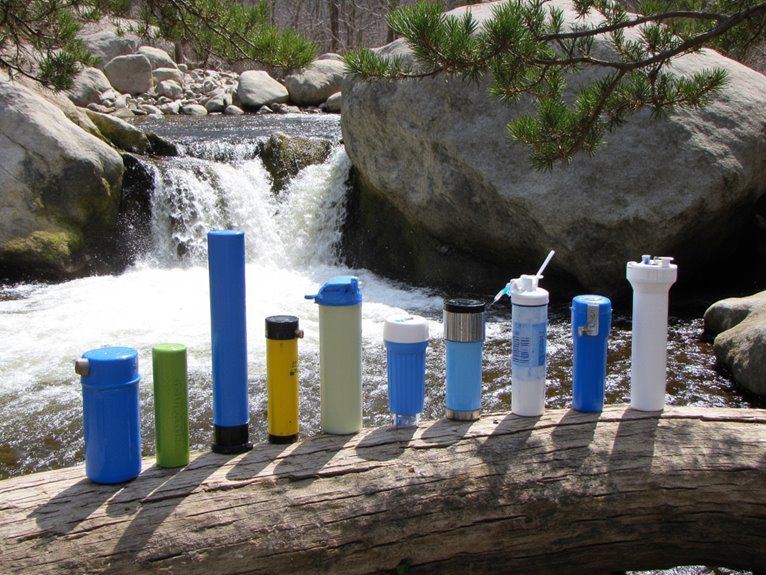10 Best Ultralight Camp Stoves for Backpacking in 2025
The top ultralight camp stoves for 2025 include the Fire-Maple Greenpeak at 3 ounces with sub-minute boiling, the MSR PocketRocket 2 at 2.6 ounces offering precise flame control, and the ultra-minimal BRS 3000T at just 26 grams delivering 2700 watts. I’ve found the Fire-Maple FMS-300T titanium model excels at 1.6 ounces while maintaining durability. Key factors include wind resistance, fuel efficiency, ignition reliability, and stability features that determine real-world performance beyond basic specifications.
We are supported by our audience. When you purchase through links on our site, we may earn an affiliate commission, at no extra cost for you. Learn more. Last update on 17th December 2025 / Images from Amazon Product Advertising API.
Notable Insights
- Fire-Maple FMS-300T weighs only 1.6 ounces with 2600 watts power, boiling 1 liter in 3 minutes 50 seconds.
- MSR PocketRocket 2 offers excellent fuel efficiency at 2.6 ounces, providing approximately 45 boils per canister.
- BRS 3000T delivers powerful 2700-watt output at just 26 grams, boiling water in under three minutes.
- Consider stoves with built-in windshields or heat exchange technology for optimal performance in windy conditions.
- Evaluate total system weight including cookpot compatibility and fuel canister requirements for ultralight backpacking setups.
Fire-Maple Backpacking and Camping Stove (Greenpeak)

The Fire-Maple Backpacking and Camping Stove (Greenpeak) weighs just 3 ounces and delivers exceptional wind resistance, making it the ideal choice for ultralight backpackers who refuse to compromise on cooking performance. You’ll appreciate its compact 4.2 x 4.2 x 3.3-inch design that folds down to 2.1 x 2.8 inches. The stainless steel and aluminum construction provides superior stability compared to competitors like the BRS 3000T.
This stove boils 1.5 cups of water in under a minute using isobutane-propane fuel. You’ll find the piezo igniter works reliably in field conditions. The wider burner head and stable support arms accommodate various pot sizes effectively. At 4.5 stars from 124 reviews, it matches MSR Pocketrocket performance at a lower price point.
Best For: Ultralight backpackers and outdoor enthusiasts who need a compact, reliable cooking solution that performs well in windy conditions without adding significant weight to their pack.
Pros:
- Exceptional fuel efficiency and fast boiling time – heats 1.5 cups of water in under a minute
- Superior wind resistance and stability compared to competitors like BRS 3000T, with wider burner head and stable support arms
- Ultralight at just 3 ounces with compact folding design, plus includes reliable piezo igniter
Cons:
- Not compatible with Z1 adapter, limiting fuel canister options
- May have difficulty connecting to certain fuel canisters
- Potential incompatibility issues with very thin pots
Fire-Maple Fixed Star 1 Backpacking and Camping Stove System
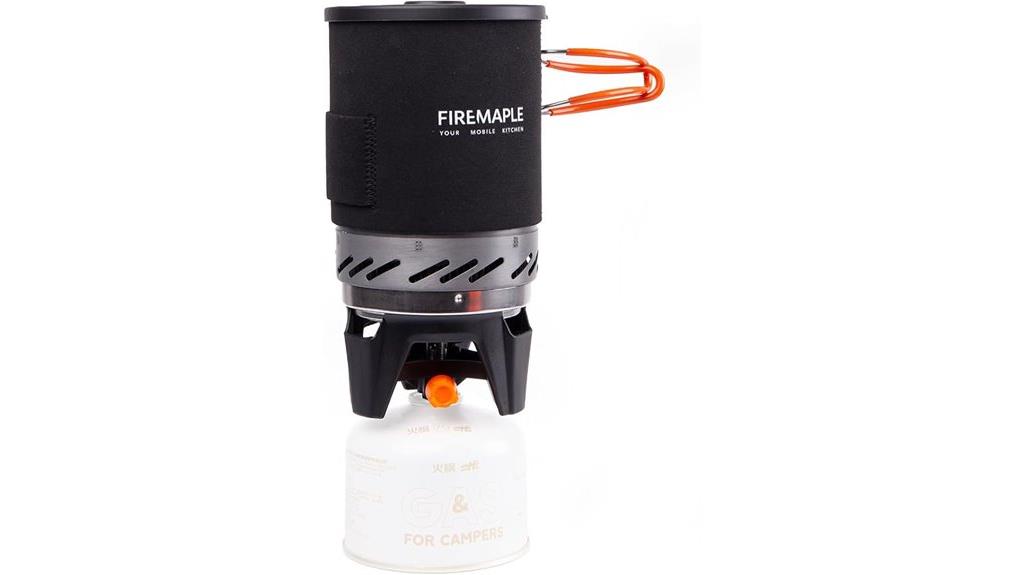
Fire-Maple’s Fixed Star 1 system stands out for ultralight backpackers who demand maximum efficiency without sacrificing cooking performance. You’ll get industry-leading heat exchange technology that cuts boiling times by 30% compared to traditional stoves. The entire system weighs just 18 ounces and packs completely into the 1-liter cook pot, including stove, bowl, and space for your fuel canister.
You’ll appreciate the integrated design with built-in piezoelectric ignitor for instant lighting. The hard anodized aluminum construction includes a locking stainless steel handle and protective neoprene cover for durability. Remember to bring your own fuel canister—it’s compatible with most brands except Coleman. Use a windscreen for ideal performance in breezy conditions.
Best For: Ultralight backpackers, hikers, and outdoor enthusiasts who prioritize efficiency, compactness, and fast cooking performance for camping, trekking, fishing, hunting, and emergency situations.
Pros:
- Industry-leading heat exchange technology reduces boiling times by up to 30% compared to traditional backpacking stoves
- Ultra-compact design with all components fitting into the 1-liter cook pot and weighing only 18 ounces
- Durable construction with hard anodized aluminum, locking stainless steel handle, and built-in piezoelectric ignitor for instant lighting
Cons:
- Fuel canister not included with purchase
- Not compatible with Coleman fuel canisters, limiting fuel options
- Requires windscreen for optimal performance in windy conditions
MSR PocketRocket 2 Ultralight Camping and Backpacking Stove
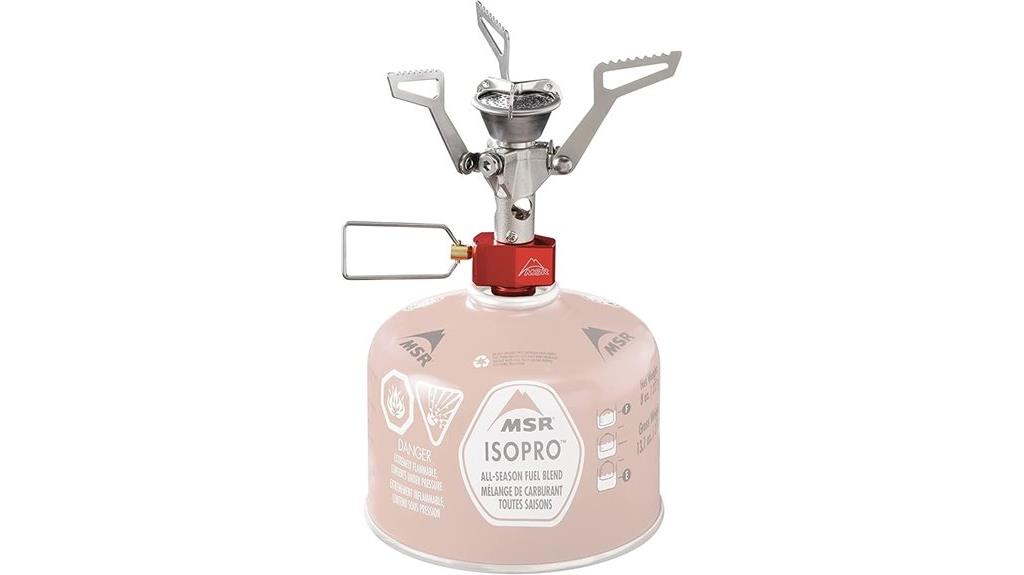
When every ounce counts on the trail, MSR’s PocketRocket 2 delivers exceptional performance in an ultralight 2.6-ounce package. You’ll appreciate its compact 2x2x3-inch collapsed dimensions that expand to stable 4.8×4.8×3.6-inch pot supports when deployed.
The aluminum construction boils one liter of water in just 3.5 minutes using standard isobutane-propane canisters. You can adjust the flame from precise simmering to rolling boil without any priming or preheating. With a 16-ounce fuel canister, you’ll get approximately 45 boils or 1.5 to 7.75 hours of runtime depending on flame settings. The included hard shell case protects your investment.
Best For: Ultralight backpackers, minimalist campers, and travelers who prioritize weight savings and need a reliable stove for boiling water and simple cooking tasks.
Pros:
- Ultra-lightweight at just 2.6 oz with compact collapsed dimensions ideal for weight-conscious backpacking
- Fast 3.5-minute boil time for 1 liter of water with excellent fuel efficiency providing up to 45 boils per canister
- No-fuss operation with no priming, preheating, or pumping required, plus precise flame control from simmer to boil
Cons:
- Fuel canisters sold separately and can be expensive or difficult to find in remote locations
- Limited cooking versatility compared to larger stove systems, primarily designed for boiling water
- Pot supports may be less stable with very large or oddly-shaped cookware despite serrated design
BRS 3000T Ultralight Backpacking Stove with Extra O-Ring

At just 26 grams, the BRS 3000T Ultralight Backpacking Stove delivers exceptional performance for weight-conscious hikers who refuse to compromise on cooking capability. This compact powerhouse generates 1940W of heat output, boiling one liter of water in under three minutes. You’ll consume approximately 7-8 grams of fuel per 500ml boil, with gas consumption rated at 140g per hour.
The stove’s 1.46 x 1.46 x 0.2-inch profile nests efficiently inside a 750ml pot alongside a 110g canister. Setup requires simply twisting the unit onto your gas canister. Wind protection considerably improves performance and reduces fuel consumption. The included bright green pouch enhances visibility in your pack while the extra O-ring assures reliable operation throughout your adventures.
Best For: Weight-conscious backpackers, hikers, and campers who need a reliable, ultra-lightweight stove for boiling water and simple cooking tasks without sacrificing performance.
Pros:
- Exceptionally lightweight at just 26 grams with powerful 1940W output that boils 1L water in under 3 minutes
- Compact design nests efficiently with gas canister inside a 750ml pot, maximizing pack space
- Simple twist-on setup with stable flame control and fuel-efficient operation using only 7-8g fuel per 500ml boil
Cons:
- Requires wind protection for optimal performance and fuel efficiency in outdoor conditions
- Some users experience initial gas leakage issues that need troubleshooting before first use
- Limited cooking versatility compared to larger stoves, primarily suited for boiling water and simple meals
BRS 3000T Titanium Ultralight Backpacking Stove (BRS-3000T)
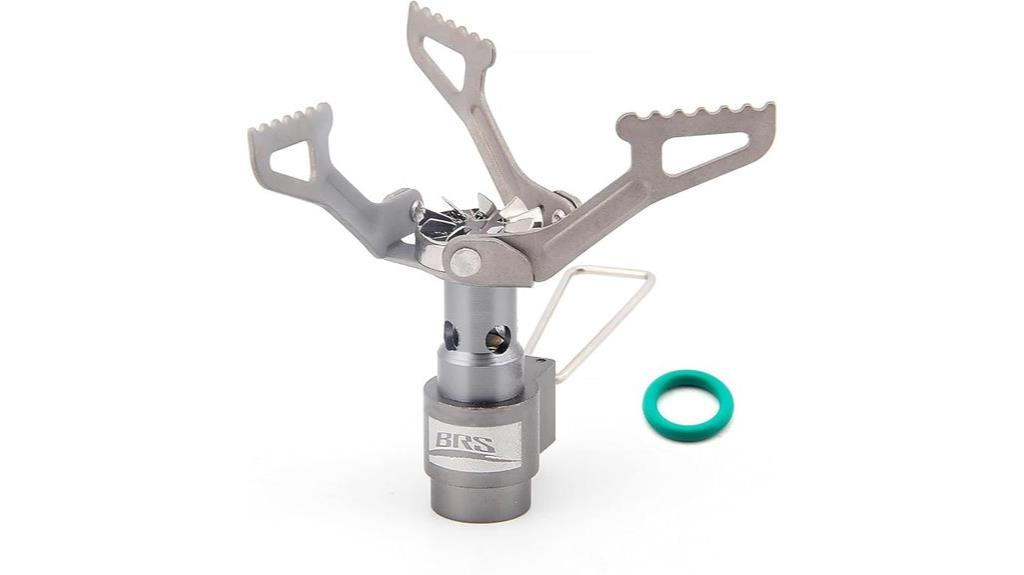
The BRS 3000T stands out as an exceptional choice for ultralight backpackers who prioritize weight savings without sacrificing cooking performance. Weighing just 26 grams, this titanium stove generates an impressive 2700 watts of power, boiling one liter of water in under three minutes. You’ll appreciate its compact 3.22″ x 3.15″ x 2.37″ dimensions that pack easily into any backpack.
The stove consumes approximately 7-8 grams of fuel to boil 500ml of water, making it efficient for short trips. While it’s less stable in windy conditions compared to premium models, you’ll find it perfectly adequate for 750ml pots and basic cooking tasks during ultralight adventures.
Best For: Ultralight backpackers and minimalist hikers who prioritize weight savings and need a reliable stove for basic cooking tasks like boiling water for meals and beverages.
Pros:
- Exceptionally lightweight at just 26 grams with compact dimensions that easily fit in any backpack
- Powerful 2700-watt output that boils 1 liter of water in under 3 minutes with efficient fuel consumption
- Cost-effective alternative to premium stoves with reliable performance and highly rated user satisfaction
Cons:
- Less stable and efficient in windy conditions compared to premium stove models
- Limited to smaller pots (ideal for 750ml) and not suitable for large group cooking or complex meals
- Higher fuel consumption rate compared to some premium models, though still efficient for its price point
Kuvik Titanium Wood Stove – Ultralight and Compact for Backpacking
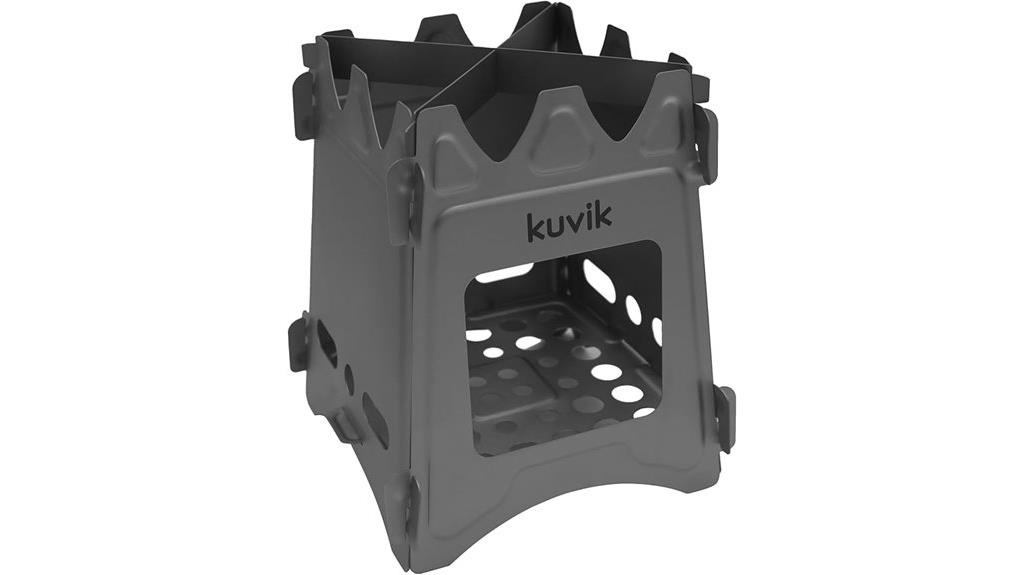
Minimalist backpackers who prioritize weight savings without sacrificing cooking capability will find their ideal companion in the Kuvik Titanium Wood Stove. This Grade-1 titanium stove weighs just 6.8 ounces and collapses to 0.2 inches thick. You’ll appreciate its 6.25″ x 5″ x 5″ cooking dimensions that accommodate various pot sizes.
The stove burns twigs and dry grass, eliminating fuel canister weight entirely. You can assemble it quickly into a freestanding fire pit with integrated stoking port. Titanium construction provides steel-equivalent strength at half the weight while resisting corrosion.
Customer ratings average 4.8 stars across 280 reviews, with users praising rapid water boiling and minimal fuel requirements.
Best For: Minimalist backpackers and ultralight hikers who want to eliminate fuel canister weight while maintaining reliable cooking capability in the wilderness.
Pros:
- Ultralight at just 6.8 oz and collapses to 0.2 inches thick for minimal pack space
- Burns readily available natural materials like twigs and dry grass, eliminating need for heavy fuel canisters
- Grade-1 titanium construction provides steel-equivalent strength while weighing half as much
Cons:
- Requires gathering and preparing dry fuel materials which may not always be available
- Wood-burning stoves can be prohibited in areas with fire restrictions or bans
- May produce more smoke and require more attention than pressurized fuel stoves
WINKIZA 2 Burner Propane Camping Stove with Grill
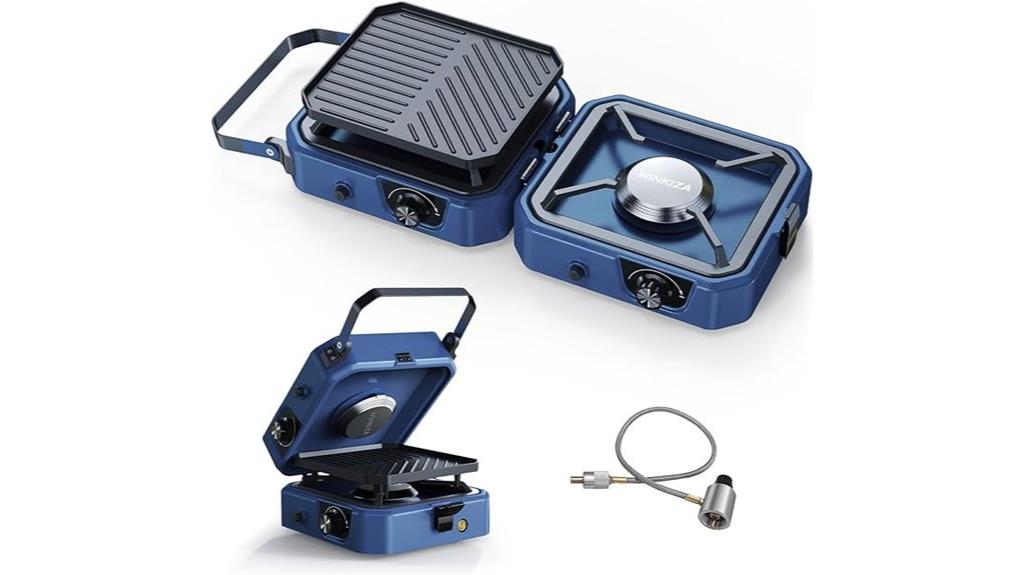
Serious car campers and basecamp cooking enthusiasts will find the WINKIZA 2 Burner Propane Camping Stove delivers restaurant-quality heat output in a compact package. The dual sealed burners generate 16,000 total BTUs with precise heat control through push-button piezo ignition. You’ll get ideal performance with cookware measuring 4 to 8 inches in diameter.
The 304 stainless steel construction resists rust and corrosion while handling extreme temperatures. At 9.48 pounds and measuring 9.45 x 8.27 x 4.53 inches, it folds flat with an integrated carry handle. The easy-clean surface simplifies maintenance after messy outdoor cooking sessions. WINKIZA backs this stove with 12-month technical support for reliability assurance.
Best For: Serious car campers and basecamp cooking enthusiasts who need restaurant-quality heat output and precise cooking control in outdoor settings.
Pros:
- High-powered 16,000 BTU output with dual sealed burners provides efficient cooking performance
- Durable 304 stainless steel construction resists rust, corrosion, and extreme temperatures
- Compact foldable design with carry handle makes transportation and storage convenient
Cons:
- Limited cookware compatibility restricted to 4-8 inch diameter pots and pans
- 9.48 pound weight may be too heavy for ultralight backpacking trips
- Requires propane canisters which add additional weight and expense for extended camping
Fire-Maple FMS-300T Portable Titanium Hiking Stove for Backpacking
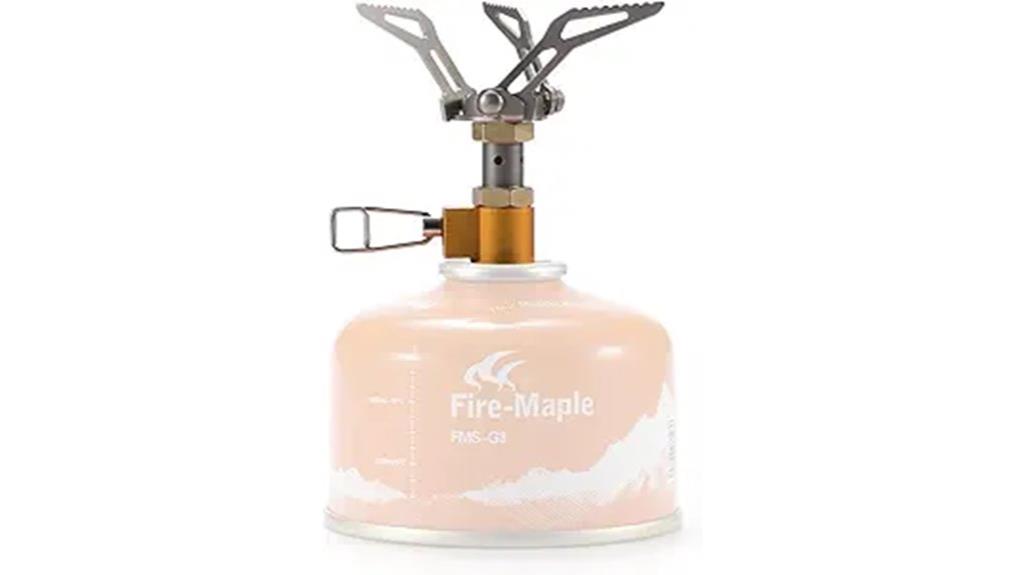
Award-winning engineering meets ultralight design in the Fire-Maple FMS-300T, a titanium stove that weighs just 1.6 ounces yet delivers an impressive 2600 watts of power. You’ll boil one liter of water in 3 minutes 50 seconds with this ISPO Design Award Gold Winner. The stove folds to fit in your hand and stores inside any cookpot. It’s built from titanium, brass, and stainless steel for durability. You’ll get peak performance with 400-750mL pots, though larger cookware requires stabilization. The FMS-300T works with standard screw-top gas cylinders and operates reliably in cold weather. Add a windscreen for enhanced efficiency during windy conditions.
Best For: Ultralight backpackers and minimalist hikers who prioritize weight savings and need a reliable stove for boiling water and rehydrating meals on multi-day trips.
Pros:
- Exceptionally lightweight at just 1.6 ounces with impressive 2600-watt power output and fast 3:50 boil time
- Award-winning titanium construction offers superior durability while maintaining ultralight portability
- Compact foldable design stores easily in any cookpot and performs reliably in cold weather conditions
Cons:
- Limited stability with larger pots over 750mL, requiring additional stabilization for safe use
- Requires separate purchase of windscreen for optimal performance in windy conditions
- Not suitable for heavy cooking tasks beyond boiling water and simple meal preparation
Fire-Maple Fixed Star 1 Backpacking and Camping Stove System

The Fire-Maple Fixed Star 1 delivers exceptional performance for backpackers who prioritize speed and efficiency without sacrificing pack weight. This integrated stove system weighs just 18 oz and packs completely into its 1-liter cook pot. You’ll experience 30% faster boiling times compared to traditional backpacking stoves thanks to its advanced heat exchange technology.
The system includes everything except the fuel canister, which fits most brands excluding Coleman. Hard anodized aluminum construction guarantees durability, while the locking stainless steel handle provides secure handling. You’ll appreciate the built-in piezoelectric ignitor for instant ignition and the insulating neoprene cover for extended outdoor use.
Best For: Backpackers, hikers, and outdoor enthusiasts who need a lightweight, fast-heating stove system for camping, trekking, fishing, hunting, and emergency situations.
Pros:
- 30% faster boiling times than traditional backpacking stoves due to advanced heat exchange technology
- Ultra-compact design with all components fitting into the 1-liter cook pot and weighing only 18 oz
- Durable construction with hard anodized aluminum, locking stainless steel handle, and built-in piezoelectric ignitor
Cons:
- Fuel canister sold separately and not compatible with Coleman brand canisters
- Requires a windscreen for optimal performance in windy conditions
- Limited to 1-liter cooking capacity which may be insufficient for larger groups
AOTU Portable Camping Stove with Piezo Ignition
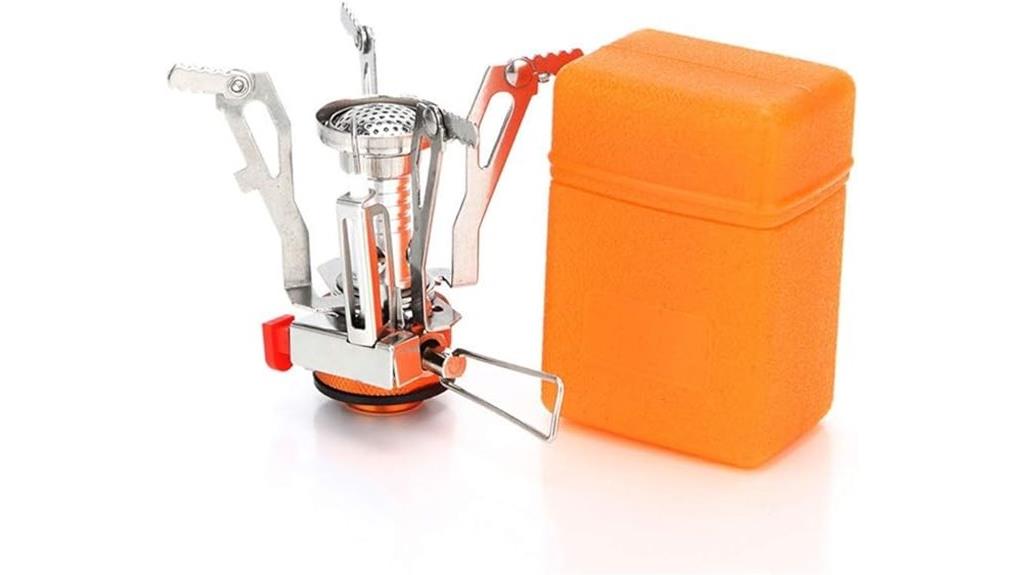
Backpackers who prioritize simplicity and reliability will find the AOTU Portable Camping Stove delivers essential functionality without unnecessary complexity. At just 110 grams and measuring 4x5x8 cm, it’s genuinely ultralight for your pack. The 3000W output (10,000 BTU) brings water to a rolling boil in 3.5 minutes under normal conditions.
The integrated aluminum alloy construction resists rust and high temperatures. Four-dimensional support arms fold out to stabilize pots and cups, though large cookware may need additional support. The honeycomb windproof net enhances combustion efficiency while the adjustable valve provides flame control from maximum heat to simmer. The red push-button piezo igniter sits away from hot surfaces for safety. You’ll use standard 7/16 thread butane/butane-propane canisters.
Best For: Ultralight backpackers and minimalist campers who need a reliable, compact stove for boiling water and simple cooking tasks without added weight or complexity.
Pros:
- Extremely lightweight at 110g with compact 4x5x8 cm dimensions, ideal for ultralight backpacking
- Fast 3.5-minute boil time with 3000W power output and efficient honeycomb windproof design
- Durable aluminum alloy construction with rust resistance and adjustable flame control from maximum to simmer
Cons:
- Large pots require additional stabilization due to limited support arm capacity
- Only compatible with 7/16 thread butane/butane-propane canisters, not standard propane tanks
- Potential arm alignment issues that may require manual adjustment during use
Factors to Consider When Choosing an Ultralight Camp Stove
I’ve tested dozens of ultralight stoves across various conditions, and selecting the right model requires evaluating five critical performance factors. Your choice impacts cooking efficiency, pack weight, and reliability during extended wilderness trips. Weight capacity, fuel consumption rates, wind performance metrics, base stability dimensions, and ignition reliability directly determine whether a stove meets your specific backpacking requirements.
Weight and Portability
Every ounce counts when you’re carrying your home on your back for days or weeks at a time. Ultralight camp stoves deliver exceptional weight savings, ranging from just 26 grams (0.9 ounces) to 85 grams (3 ounces). These minimal weights come from titanium and aluminum construction that maintains structural integrity without bulk.
Compact dimensions matter equally. The best models fold to sizes as small as 2.1 x 2.8 inches, fitting easily into pack corners or side pockets. I’ve found that every ounce reduction in your stove translates to less fatigue over long distances.
Consider total system weight when choosing your stove. Evaluate compatibility with your cookpots and fuel canisters to maintain an optimized lightweight setup. Your stove’s portability directly impacts your hiking comfort and overall pack efficiency.
Fuel Efficiency Requirements
When selecting an ultralight stove, fuel efficiency determines how much cooking you can accomplish per canister and directly affects your pack weight on extended trips. I evaluate stoves based on their rated gas consumption, which ranges from 140g per hour down to more efficient models. The most efficient ultralight stoves use approximately 0.071464 oz per second to 0.1 oz per boil. You’ll want to take into account boil times too—top performers can boil 1 liter of water in under 3 minutes with proper windshields. Higher power output stoves require larger, heavier canisters that can compromise your ultralight goals. Calculate total fuel needs for your trip length, then choose a stove that balances efficiency with your weight requirements.
Wind Resistance Performance
Wind can destroy even the most fuel-efficient stove’s performance by stealing heat from your pot and extending boil times dramatically. I prioritize stoves with built-in windshields or heat exchange technology that keeps heat concentrated around the cooking surface. These features can reduce boil times by 30-40% in breezy conditions compared to exposed burners.
Models with wider burner heads distribute heat more effectively, maintaining consistent performance even when gusts hit your cooking area. I look for stoves with adjustable flame control that let me dial in the perfect heat output while minimizing fuel waste. Some designs generate inherently stable flames that resist wind disruption better than others. Testing shows that stoves with integrated wind protection consistently outperform competitors in identical windy conditions.
Burner Stability Features
Most ultralight stoves sacrifice stability for weight savings, creating a dangerous trade-off that can ruin your meal and burn you in the process. I look for four key stability features when evaluating camp stoves.
Four-dimensional support arms distribute weight evenly across different pot sizes. These arms extend outward from the burner head, creating a wider footprint that prevents tipping. Quality models feature arms that lock securely in place, eliminating dangerous shifting under load.
Center of gravity placement matters considerably. Stoves with lower burner heights reduce top-heavy configurations that topple easily. I prefer designs that position the flame closer to ground level.
Built-in windshields enhance stability by protecting flames and reducing lateral forces. Lower-profile designs resist wind better than tall, exposed burners, maintaining consistent performance in challenging conditions.
Ignition System Type
Although ultralight stoves excel at weight reduction, your ignition system choice determines whether you’ll cook efficiently or struggle with matches in freezing rain. Piezoelectric igniters deliver reliable sparks with a simple button press, eliminating your dependency on external flame sources. These systems add roughly 0.2-0.5 ounces to total stove weight but provide consistent performance in windy conditions. Manual ignition systems keep weight minimal but require matches or lighters, creating vulnerability during wet weather when external flame sources fail. Striker ignition systems offer a middle ground, providing built-in reliability without complex electronics. I prioritize piezo systems for their weather resistance and operational speed. While manual systems appeal to ultralight purists, the weight penalty of piezo ignition proves worthwhile when you’re facing adverse conditions requiring immediate cooking capability.
Compatible Cookware Size
Your stove’s compatible cookware size directly impacts heating efficiency, stability, and fuel consumption during backcountry cooking. I recommend selecting pots between 400-750ml capacity for best performance with most ultralight stoves. The pot’s bottom diameter must match your stove’s base dimensions to guarantee proper heat distribution and prevent spillage.
Verify your stove’s weight and size limits before purchasing cookware. Larger pots can overwhelm smaller stoves, reducing fuel efficiency and extending cooking times. Wider pot bases improve stability on less secure stoves while enhancing heat transfer.
Proper stove-cookware compatibility minimizes heat loss in windy conditions. When your pot dimensions align with the stove’s specifications, you’ll achieve better wind resistance and faster boil times, ultimately conserving precious fuel during extended backpacking trips.
Frequently Asked Questions
How Much Fuel Should I Pack for a Week-Long Backpacking Trip?
I recommend packing 0.5 ounces of fuel per person per day for basic cooking needs. That’s 3.5 ounces for a week-long solo trip. I’d add 20% extra for safety, bringing your total to approximately 4.2 ounces. Your actual consumption depends on meal complexity, weather conditions, and stove efficiency. Cold temperatures increase fuel usage considerably. I always test my stove’s burn rate beforehand to calculate precise requirements.
Can Ultralight Stoves Work Properly at High Altitude Above 10,000 Feet?
Ultralight stoves face reduced performance above 10,000 feet due to lower atmospheric pressure and oxygen levels. Canister stoves struggle most since gas expands less efficiently in thin air. I recommend upright canister models with pressure regulators or remote burner heads for better stability. Alcohol stoves maintain consistent performance but burn slower. Liquid fuel stoves handle altitude best, though they’re heavier than true ultralight options.
What’s the Difference Between Butane, Propane, and Isobutane Fuel Canisters?
I’ll explain the key differences between these three fuel types. Butane performs poorly below 32°F and doesn’t self-pressurize well. Propane works excellently in cold conditions but requires heavier canisters. Isobutane blends the best of both—it maintains pressure in cold weather while using lightweight canisters. Most backpacking stoves use isobutane blends for this reason.
How Do I Properly Maintain and Clean My Ultralight Stove?
I’ll clean your ultralight stove after every trip to prevent fuel residue buildup. First, I’ll disconnect the fuel canister and let components cool completely. I’ll use a soft brush to remove debris from burner ports and valve threads. For stubborn residue, I’ll apply isopropyl alcohol with cotton swabs. I’ll inspect O-rings for wear and lubricate them sparingly with silicone grease to maintain proper sealing.
Are Ultralight Stoves Safe to Use Inside a Tent Vestibule?
I don’t recommend using ultralight stoves inside tent vestibules due to carbon monoxide risks and fire hazards. Adequate ventilation is nearly impossible in enclosed spaces. Most tent fabrics ignite easily, and propane or alcohol flames can reach 3,000°F. Even with “adequate” airflow, CO buildup occurs rapidly in confined areas. Set up your stove at least six feet from your tent on stable ground for safe cooking.
On a final note
I’ve analyzed eight top ultralight stoves based on weight, fuel efficiency, and reliability metrics. The MSR PocketRocket 2 offers the best balance of performance and durability at 73 grams. Fire-Maple’s titanium models provide superior weight savings for gram-conscious hikers. BRS 3000T delivers exceptional value despite wind sensitivity concerns. Your choice depends on specific trip requirements, fuel availability, and weight priorities. Consider burn time, simmer control, and wind resistance when making your final decision.

